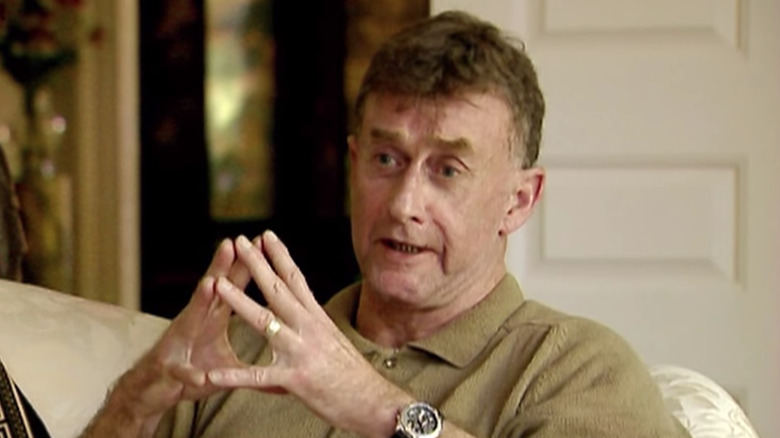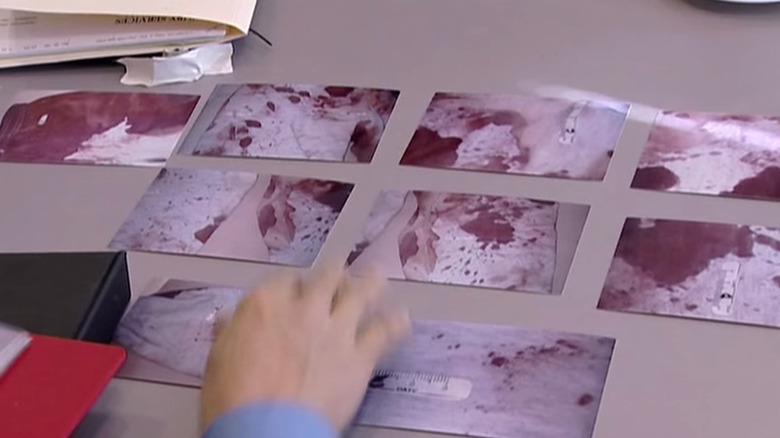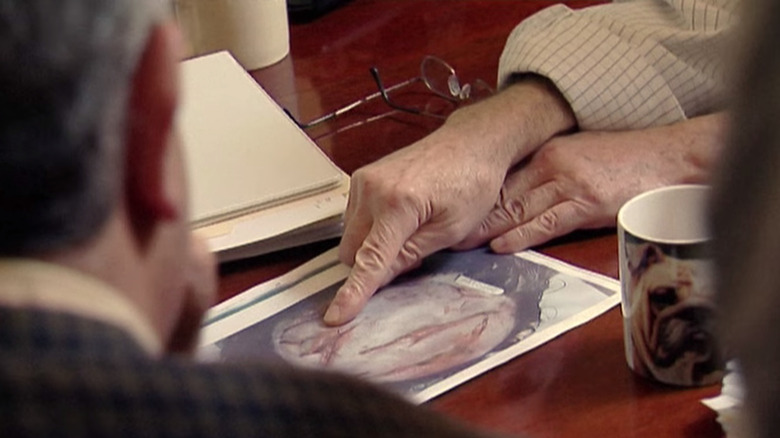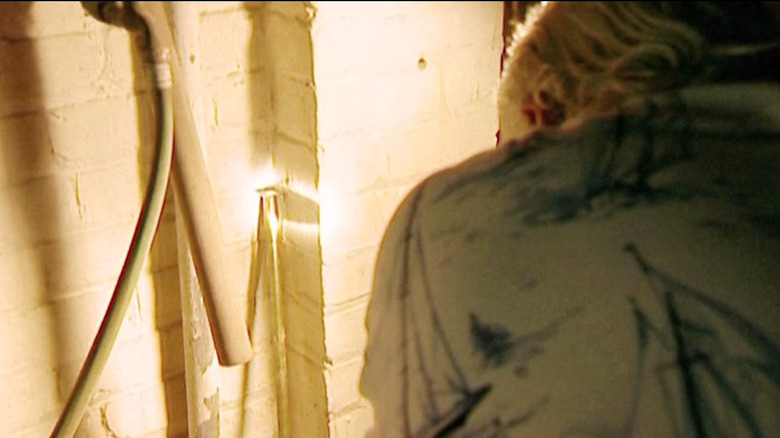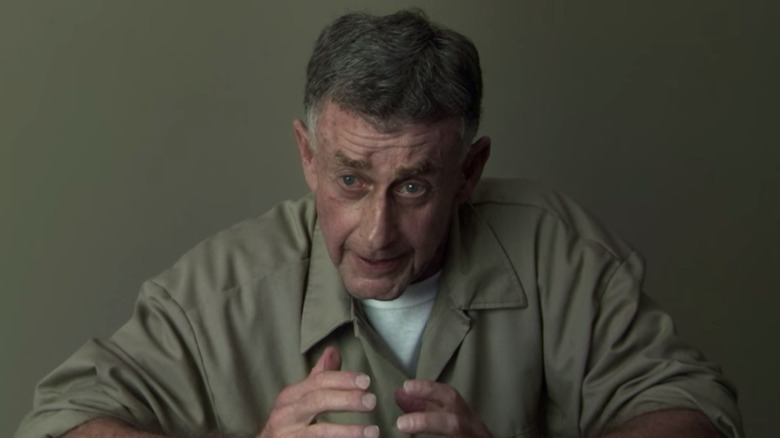The Michael Peterson Murder Trial Explained
On the surface, Michael Peterson's family life appeared to be happy, even idyllic. "My parents Michael and Kathleen had the most loving relationship ever," Caitlin Atwater, the daughter of Michael's second wife, Kathleen, told NBC News. "They were the most ideal parents." In addition to being Caitlin's stepfather, Michael had taken on a fatherly role for sisters Martha and Margaret after the death of their mother, who had been a friend of the Peterson family.
Michael was a successful novelist who wrote about the Vietnam War and dabbled in politics. Kathleen was a thriving business executive who made six figures a year. As Atwater told NBC News, the couple fought, but any disputes would blow over quickly. In 1992, Michael and Kathleen bought a 14-room mansion at 1810 Cedar Street in Durham, North Carolina.
But the Peterson family would soon be hit by a puzzling tragedy that would haunt them, local authorities, and the world for years to come. It would lead to years of extensive investigations, countless hours in courtrooms, several clues, and questions, and twists and turns — but few definitive answers. Here's more on the complex saga of the Michael Peterson murder trial.
The Petersons were stressed, financially and otherwise
During the first week of December 2001, Michael and Kathleen Peterson had already started decorating their house for Christmas. The empty-nesters were excited to have their six children over for the holidays, as Caitlin Atwater told NBC News. Kathleen was also ready for a break from her stressful work life. Stock for Nortel, the company for which she was a leading executive, was taking a nosedive. Sweeping layoffs soon followed, and Kathleen was not exempt. She began taking Valium to quell her anxieties. "It was devastating," Atwater told NBC News. "She threw her life into that company. And it wasn't just work that was stressing her out. She had to lay off her own boss."
Michael had also experienced struggles in his professional life. During an unsuccessful mayoral campaign a few years prior, he had been caught lying about receiving two Purple Hearts during the Vietnam War. "It's just a bit of a lie that starts to exponentially grow over a period of time," his brother, Bill Peterson, told NBC News. "And there's nothing you can do about it. It got out of control." Michael then ran for city council in the fall of 2001, and lost.
On top of the job insecurity and public embarrassments, the Peterson family had amassed credit card debt of $143,000, per The Item. Needless to say, as 2001 wound down, tensions in the Peterson mansion were running high.
Michael Peterson said he discovered Kathleen at the foot of their staircase
At 2:40 a.m. on December 9, 2001, Michael Peterson placed a telephone call to 911. He told the operator that Kathleen Peterson had had "an accident," that "she fell down the stairs," and that "she [was] still breathing" but "not conscious" (via CNN). He said she had fallen down 15 or 20 steps.
While speaking to Michael, the dispatcher wrote the word "hysterical" to describe his demeanor, according to CNN. By the time first responders arrived on the scene several minutes after Michael placed the call, Kathleen was dead.
When asked to retrace his and Kathleen's steps in the hours prior to the call, Michael said they had watched the movie "America's Sweethearts," drank some wine and talked, and then headed outside to sit by pool (via ABC News). He said Kathleen had then gone inside to go to bed while he stayed outside smoking his pipe for 30 to 45 minutes, before discovering Kathleen in a pool of blood at the foot of the staircase inside their house. But law officials grew suspicious of the mysterious and gruesome nature of Kathleen's death. A homicide investigation began with Michael as the prime suspect.
The defense and prosecution teams disagreed about the blood spatter
One of the major sources of suspicion in Kathleen Peterson's death was the large amount of blood at the scene. But when the defense team brought in leading forensic expert Dr. Henry Lee, he said that, contrary to popular belief, the blood at the scene indicated Kathleen's death was more likely to be an accident than the result of a fatal beating, as a beating would most likely not produce that much blood. "These medium-velocity patterns can be produced by coughing, sneezing, breathing, movement of the hair," Lee said of the blood spatter on the walls at the bottom of the staircase (via WRAL), but added that he could not exclude the possibility that Kathleen was beaten.
The prosecution team saw the scene a little differently, pointing to the blood found inside Michael Peterson's shorts. They said that evidence placed Michael at the scene of the crime, while Lee said that blood could have come from Kathleen coughing on Michael, as Michael stated she was still breathing when he found her. Lee also said that any blood spatter analysis would be inconclusive. "It doesn't matter how many tests you do," he said. "You're not going to produce the same scene because this is a dynamic situation. You can jump. You can beat a mannequin head. That's not real life."
Local investigators found Kathleen's scalp lacerations consistent with homicidal assault
In the autopsy report for Kathleen Peterson, medical examiner Deborah Radisch noted several injuries, including but not limited to "multiple lacerations and avulsions," or deep cuts and tears, on the back of Kathleen's head; crushed thyroid cartilage at her throat; and bruises on her "back, posterior arms, wrists, and hands." Radisch concluded that these injuries were the result of a beating. "In my opinion, the cause of death in this case was due to severe concussive injury of the brain caused by multiple blunt force impacts of the head," she noted. "Blood loss from the deep scalp lacerations may have also played a role in her death. The number, severity, locations, and orientation of these injuries are inconsistent with a fall down stairs; instead, they are indicative of multiple impacts received as the result of a beating."
According to CNN, prosecution witness Dr. Kenneth Snell initially found Kathleen's death to be an accident, but changed his mind when he saw the seven lacerations on her head. Snell noted that two of these wounds showed signs of tearing, and therefore stated that a weapon such as a crowbar or fireplace poker was likely used to inflict them. Another prosecution witness, forensic meteorologist William Haggard, analyzed the weather conditions on the night of Kathleen's death and concluded that it would have been too cold for Michael to comfortably stay outside for as long as he said he did, especially because he was wearing shorts and a t-shirt at the time.
The prosecution team pointed to Michael Peterson's secret 'gay life' as a possible motive
Michael Peterson's marriage to Kathleen Peterson was often characterized by those who knew them as an ideal, loving, "storybook" romance. But during the trial, the prosecution presented emails and photos that told a slightly different story. They introduced hundreds of deleted pornographic images from Michael's computer, many of which were of men, per CNN. The prosecution also showed that Michael had exchanged 20 emails with 28-year-old Brent Wolgamott, whom he met on an online message board for gay men, over the course of a week in late August and early September 2001. According to the testimony, the correspondence was intended to lead to a sexual encounter, but Wolgamott stood Michael up.
While testifying in court, Wolgamott made it clear that he had never met Michael, and stated that Michael had mentioned Kathleen in their correspondence. "He said something of the effect that he had a great marriage and he had a lot of warmth and affection for his wife," Wolgamott testified. There was no evidence that Kathleen knew about the exchange, or about her husband's bisexuality in general.
The eerily similar death of Elizabeth Ratliff raised questions
In the mid-1980s, Michael Peterson was living in Germany with his first wife, Patricia, and their sons. Michael and Patricia were close friends with a widow named Elizabeth Ratliff, who lived down the street from them with her two young daughters. On November 25, 1985, Ratliff's nanny, Barbara Malagnino, found Ratliff dead at the bottom of her staircase. According to Malagnino's testimony, lights were on in the house and Ratliff was wearing snow boots, indicating that she had died the night before, per the Herald-Journal.
The German authorities listed Ratliff's cause of death as a brain hemorrhage. Following Ratliff's death, Michael adopted her two young daughters, Martha and Margaret, per Court TV.
Of course, the similarities between Ratliff's and Kathleen Peterson's deaths raised questions. The night before Ratliff's body was found, Michael and Patricia had been over for dinner, and Michael remained at Ratliff's home afterwards to help clean up. He was therefore the last known person to see her alive. In addition to the fact that Ratliff and Kathleen had both been found at the bottom of staircases, a "Tournee du Chat Noir" poster had hung in Ratliff's house in Germany, and a copy of the same poster was hanging in the staircase where Kathleen died 16 years later, per BBC.
During the murder trial, Ratliff's body was exhumed and reexamined. According to The Item, the second autopsy led a North Carolina medical examiner to conclude that Ratliff had in fact been beaten to death.
The discovery of a blow poke shook up the courtroom
One of several significant findings in the Michael Peterson murder trial was the discovery of a blow poke fireplace tool. A blow poke or similar tool had been discussed earlier in the case as a possible murder weapon. Authorities had searched for the Petersons' blow poke to no avail. Then, the missing blow poke was presented in court by the defense just two days before defense lawyer David Rudolf finished presenting his case, per Court TV. Rudolf said the tool had been found in the Petersons' garage, covered in cobwebs.
According to the Herald Sun, it was later revealed that Michael's son, Clayton, had found the blow poke. It was also later found that Michael had ordered two additional blow pokes around the time Rudolf introduced the discovered tool in court. Rudolf later claimed he had planned to use the additional blow pokes as props for demonstrations in court.
Still, lead investigator Art Holland noted that the unearthed blow poke was not mangled, as it would have been if it had been used to beat someone to death. He then said he believed the blow poke produced in court was not the murder weapon, but that he believed another blow poke was. Juror Shirley Ferrell told Court TV that the jury had dismissed the theory that a blow poke was used to kill Kathleen.
Michael Peterson was found guilty and sentenced to life in prison
On October 10, 2003, following over 13 weeks on trial, Michael Peterson was found guilty of murdering Kathleen Peterson, as reported by The Item. He was sentenced to life in prison without the possibility of parole. His adopted daughters, Martha and Margaret, sobbed as the judge read the verdict. Michael turned to the two girls and said, "I love you ... It'll be all right." He was then taken away in handcuffs and placed in a holding cell before being transferred to Central Prison in Raleigh, North Carolina.
Michael's defense lawyer, David Rudolf, immediately said he would file an appeal. "The war isn't over," he said. Prosecutor Jim Hardin disagreed. "We are exceptionally pleased that at least this chapter in this book is closed for this family," Hardin said. "We're relieved for them."
Kathleen's daughter, Caitlin Atwater, released a statement through her lawyer that said she was "thankful that justice has been served for her mother." Atwater originally assumed her stepfather was innocent, but changed her mind as more evidence was released, including that of his presumed dishonesty surrounding his sexuality. Atwater also filed a wrongful death claim against Michael, which was later settled for several million dollars. A decade later, she had still not received any of the money, per ABC.
The infamous owl theory was raised in 2009
In 2009, one of Michael Peterson's attorneys, his former neighbor T. Lawrence Pollard, raised a theory that Kathleen Peterson was killed by an owl. A single, microscopic feather had been found in Kathleen's hair during the initial examination. It was preserved in a microslide, but never presented in court. According to WRAL, Pollard claimed that evidence of any other microscopic feathers could have been accidentally destroyed when Kathleen's hair was washed prior to examination and then shaved. According to The Durham News, a small wooden slither, determined to be from a tree, was also discovered.
Dr. Alan van Norman noted that two of the lacerations on Kathleen's head resembled wounds made by a pair of talons belonging to a large bird of prey. Kate P. Davis, executive director of raptor rehabilitation nonprofit Raptors of the Rockies, stated that it is not uncommon for owls to attack humans, that they are capable of killing animals much larger than themselves, and that the lacerations on Kathleen's head resembled those made by the talons of a Barred Owl.
According to the official document for the motion to examine the feather evidence, large birds of prey were known to live in the woods near the Petersons' mansion. On the night of her death, Kathleen had been setting out Christmas decorations on her lawn. The owl theory suggested that a raptor could have mistaken the decorations for prey and gotten tangled in Kathleen's hair before she ran inside while bleeding, which could explain the blood found on the front walkway and doorframe.
A retrial was called due to failings during the initial investigation
In January 2011, the initial Michael Peterson murder trial was called into question once again after the State Bureau of Investigation fired agent Duane Deaver. According to the News Observer, Deaver's work was called into question when a man named Greg Taylor was exonerated after 17 years in prison following a trial during which Deaver withheld blood test results. Deaver's entire crime lab was called into question, despite its work on 229 criminal cases, including high-profile cases such as that of Michael Peterson.
Michael's case was reopened in December 2011 due to the dishonesty of Deaver, who was a key prosecution witness in the original trial. According to the News Record, Superior Court Judge Orlando Hudson said a new trial was necessary due to "due process violations" and "perjured testimony."
After eight years in prison, Michael was released from Durham County jail to be on house arrest while awaiting his new trial. "I have waited over eight years, 2,988 days as a matter of fact — believe me, I counted — for an opportunity to have a retrial," he said upon his release.
Michael Peterson entered an Alford plea and walked free
For his second trial, in 2017, Michael Peterson could not afford to pay an attorney and his original defense lawyer, David Rudolf, could no longer afford to work pro bono, per WRAL. The court appointed Michael an attorney named Mike Klinkosum, who had experience representing defendants in similar murder cases.
Although Michael refused to plead guilty to second-degree murder, he took an Alford plea to a voluntary manslaughter charge, per WRAL. Alford pleas allow defendants to maintain innocence while accepting that there is sufficient evidence for a conviction. Superior Court Judge Orlando Hudson sentenced Michael to 64 to 86 months in prison, and recognized his previous 89 months served, which allowed him to walk free. "I don't see it as a victory at all," Michael said after the 35-minute hearing. He described taking the plea as "the most difficult thing I've done in my life."
Kathleen Peterson's sisters were not satisfied either. "It's wrong that, after a jury sentenced him to life in prison for the murder of his wife, he gets to be a free man while Kathleen lies in her grave," Lori Campbell said. "Closure is for a door, not for my murdered sister." Kathleen's other sister, Candace Zamperini, said that Michael's Alford plea "means nothing," adding, "Michael Peterson, you are pleading guilty to voluntary manslaughter. You will be treated as guilty for murdering my sister Kathleen, and you will be a convicted felon forever."
The trial inspired TV shows including the popular docuseries The Staircase
The Michael Peterson murder trial inspired several television and radio productions, including HBO's series "The Staircase" (in which Colin Firth and Toni Collette portray Michael and Kathleen Peterson) and Jean-Xavier de Lestrade's popular 2004 documentary series "The Staircase." The 2004 series generated international interest in the case, but drew criticism for being one-sided and favoring the defense. This criticism was further stoked when it was revealed — and confirmed by de Lestrade — that one of the series' editors, Sophie Brunet, was "romantically involved" with Michael, as reported by The Wrap. "This is one of the incredible things that happened during those 15 years," de Lestrade said. "Life is really full of surprises ... But she never let her own feelings affect the course of editing."
Among the series' critics was Kathleen Peterson's sister, Candace Zamperini. "Michael Peterson was not satisfied, in my opinion, with murdering my sister," she said (via Bustle). "Now, his ultimate vanity project would begin. He would have a movie made that he could pontificate — he could tell everyone, all of you, how incompetent the Durham police and justice system was. He could proclaim in this film, again, his complete innocence."
Zamperini also criticized the lack of her own or her sister's point of view in the docuseries. De Lestrade stated in the Netflix press notes (via Bustle) that the crew "did reach out to [Zamperini] and [Campbell] many, many times over the years but they were never willing to speak with us," adding, "We really wanted to include their perspective in 'The Staircase' and it's unfortunate that we weren't able to."

